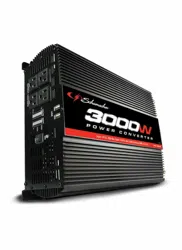Loading ...
Loading ...
Loading ...

• 5 •
3. CONVERTER LOCATION
3.1 Never place unit directly above battery;
gases from battery will corrode and
damage the converter.
3.2 Never allow battery acid to drip on unit
when reading gravity or lling battery.
3.3 Do not operate converter in a closed-in
area or restrict ventilation in any way.
4. FEATURES
• ON/OFF rocker switch
• LED indicator
Green indicates Power ON
Red indicates Overload/Interruption
in power
• 12 Volt power cord
• 120V standard AC outlets
Model PC-2000 includes 3 outlets
Model PC-3000 features 4 outlets
• USB port(s) – 5V, 2.0A
Model PC-2000 includes one port
Model PC-3000 features 2 ports
• High-speed cooling fans (2)
To keep the converter cool, the fans
speeds up as the load increases. The fans
do not run when the converter is turned off.
• Positive Battery Cable Terminal (Red)
• Negative Battery Cable Terminal
(Black)
• Ground Terminal and ground wire
Grounds converter, to protect against
electrical shock.
• Thermal Protection
When the thermal resistor exceeds
80° C (176° F), the converter shuts
down until it cools off, and then
automatically restarts.
• Surge Protection
When the power input from the vehicle’s
battery exceeds 16±0.5 volts, the
converter shuts down.
• Low-Battery Protection
When the power input from the vehicle’s
battery drops to below 10 volts, the red
LED will light, and the converter will shut
down.
5. BEFORE USING YOUR CONVERTER
Do not use the converter with a product
that draws a higher wattage than the
converter can provide, as this may cause
damage to the converter and product.
When you turn on a device or a tool that
runs on a motor, the device goes through
two stages:
1. Start Up – Requiring an initial surge
of power (commonly known as the
“starting” or “peak” load).
2. Continuous Operation – Power
consumption drops (commonly known
as the “continuous load”).
The wattage (WATTS) or amperes (AMPS)
can normally be found stamped or printed
on most devices and equipment, or in
the user’s manual. Otherwise, contact
the manufacturer to nd out whether the
device you want to use is compatible with
a modied sine wave.
To calculate the wattage:
Wattage = AMPS x 120 (AC Voltage).
To calculate the starting load:
Starting Load = 2 x wattage.
In general, the startup load of the device
or power tool determines whether your
converter has the capability to power it.
To calculate the continuous load:
Continuous Load = AMPS x 120
(AC Voltage).
IMPORTANT: Always run a test to
establish whether the converter will
operate a particular piece of equipment or
device. In the event of a power overload,
the converter is designed to automatically
shut down.
This safety feature prevents damaging
the converter while testing devices and
equipment within the wattage range of the
converter.
If a device does not operate properly
when rst connected to the converter, turn
the converter ON/OFF switch ON, OFF,
and ON again in quick succession. If this
procedure is not successful, it is likely that
the converter does not have the required
capacity to operate the device in question.
Loading ...
Loading ...
Loading ...
